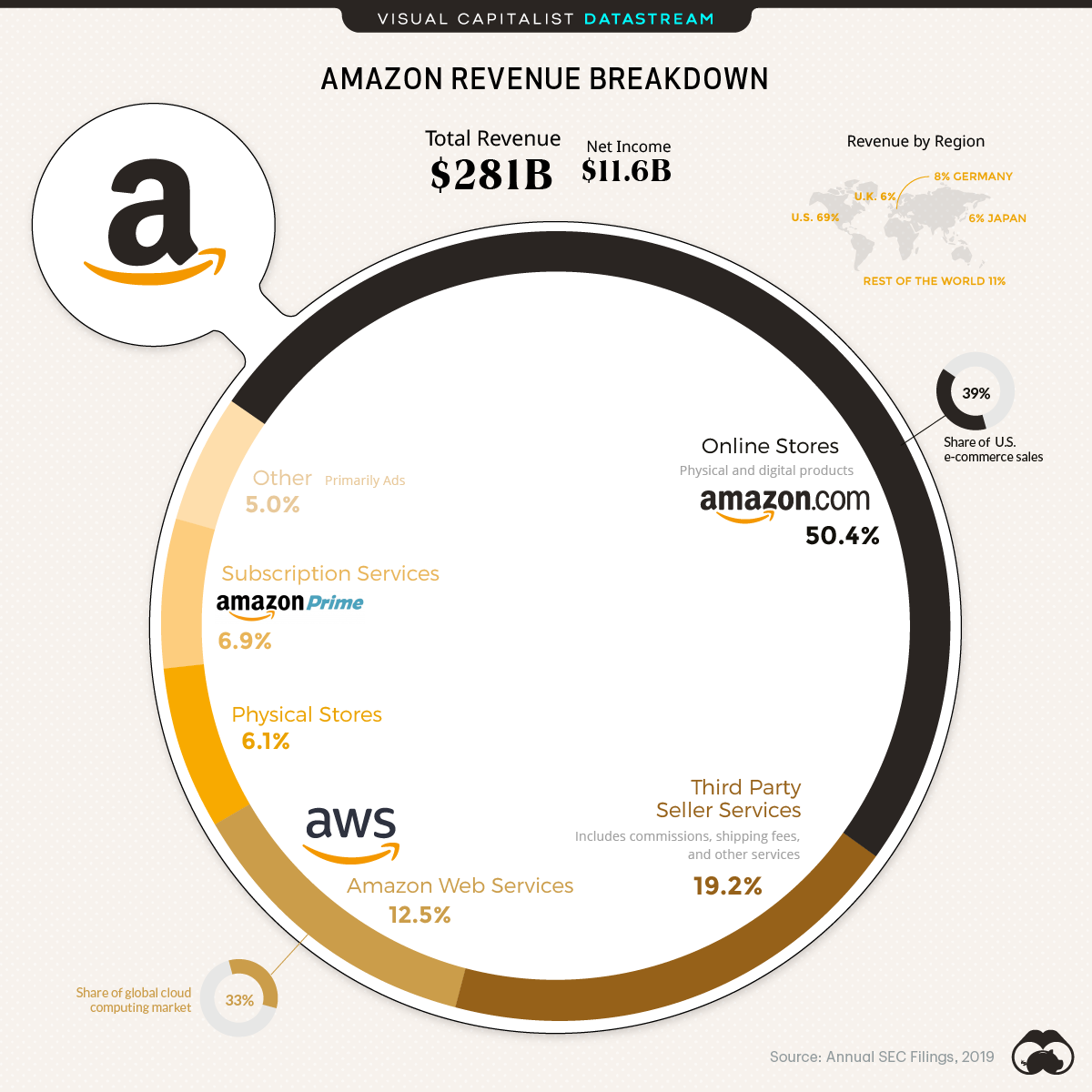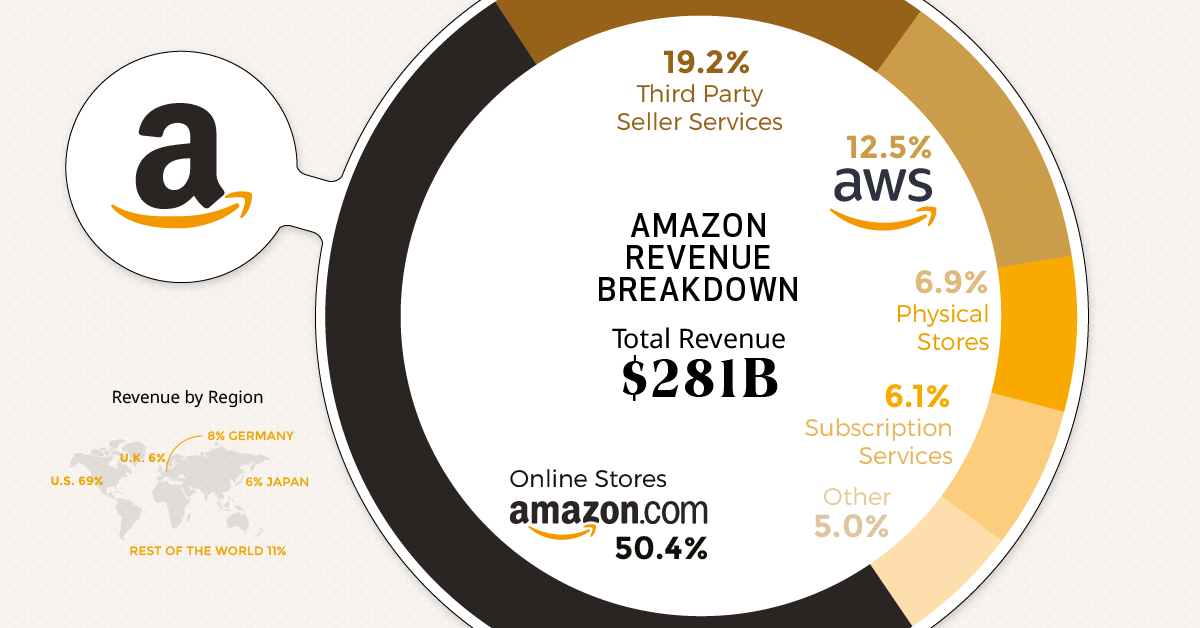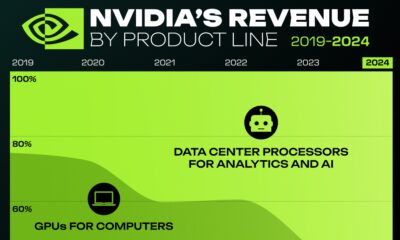Datastream
How Amazon Makes Its Money

The Briefing
- While a majority of Amazon’s revenue comes from online sales, the company has several other business segments that generate billions of dollars in revenue
- The largest business segment following online sales is third-party selling services
How Amazon Makes Its Money
With a market cap of $1.7 trillion, Amazon is the most valuable retailer in the world. But the company has grown into more than just an online store.
Amazon is now the proud owner of multiple billion-dollar revenue streams—but what are these different business segments, and how much does each unit contribute to the company’s overall revenue mix?
Here’s a look at Amazon’s different business segments, and how much each contributed to the company’s total revenue in 2019 (which was a casual $281 billion):
| Business Segment | Percent of Revenue (2019) |
|---|---|
| Online stores | 50.4% |
| Third-party seller services | 19.2% |
| Amazon Web Services (AWS) | 12.5% |
| Subscription services | 6.9% |
| Physical stores | 6.1% |
| Other | 5.0% |
While online stores generated the highest amount of revenue at 50.4%, third-party seller services made up a significant portion as well, making up 19.2% of the total.
Third-party selling has seen significant growth over the years—in 2018, it accounted for 58% of Amazon’s gross merchandise sales, which is a vast increase compared to 2000, when it made up merely 3%.
Amazon Web Services (AWS) is the third most important revenue stream, contributing 12.5% to the overall mix. However, despite contributing a relatively small percentage to total revenue in 2019, AWS made up a large portion of Amazon’s operating income, making it the key to the company’s overall profitability.
» To learn more, read our full article on How Big Tech Makes Their Billions.
Where does this data come from?
Data was sourced from directly from Amazon’s 2019 SEC filing.
Datastream
Can You Calculate Your Daily Carbon Footprint?
Discover how the average person’s carbon footprint impacts the environment and learn how carbon credits can offset your carbon footprint.

The Briefing
- A person’s carbon footprint is substantial, with activities such as food consumption creating as much as 4,500 g of CO₂ emissions daily.
- By purchasing carbon credits from Carbon Streaming Corporation, you can offset your own emissions and fund positive climate action.
Your Everyday Carbon Footprint
While many large businesses and countries have committed to net-zero goals, it is essential to acknowledge that your everyday activities also contribute to global emissions.
In this graphic, sponsored by Carbon Streaming Corporation, we will explore how the choices we make and the products we use have a profound impact on our carbon footprint.
Carbon Emissions by Activity
Here are some of the daily activities and products of the average person and their carbon footprint, according to Clever Carbon.
| Household Activities & Products | CO2 Emissions (g) |
|---|---|
| 💡 Standard Light Bulb (100 watts, four hours) | 172 g |
| 📱 Mobile Phone Use (195 minutes per day)* | 189 g |
| 👕 Washing Machine (0.63 kWh) | 275 g |
| 🔥 Electric Oven (1.56 kWh) | 675 g |
| ♨️ Tumble Dryer (2.5 kWh) | 1,000 g |
| 🧻 Toilet Roll (2 ply) | 1,300 g |
| 🚿 Hot Shower (10 mins) | 2,000 g |
| 🚙 Daily Commute (one hour, by car) | 3,360 g |
| 🍽️ Average Daily Food Consumption (three meals of 600 calories) | 4,500 g |
| *Phone use based on yearly use of 69kg per the source, Reboxed | |
Your choice of transportation plays a crucial role in determining your carbon footprint. For instance, a 15 km daily commute to work on public transport generates an average of 1,464 g of CO₂ emissions. Compared to 3,360 g—twice the volume for a journey the same length by car.
By opting for more sustainable modes of transport, such as cycling, walking, or public transportation, you can significantly reduce your carbon footprint.
Addressing Your Carbon Footprint
One way to compensate for your emissions is by purchasing high-quality carbon credits.
Carbon credits are used to help fund projects that avoid, reduce or remove CO₂ emissions. This includes nature-based solutions such as reforestation and improved forest management, or technology-based solutions such as the production of biochar and carbon capture and storage (CCS).
While carbon credits offer a potential solution for individuals to help reduce global emissions, public awareness remains a significant challenge. A BCG-Patch survey revealed that only 34% of U.S. consumers are familiar with carbon credits, and only 3% have purchased them in the past.
About Carbon Streaming
By financing the creation or expansion of carbon projects, Carbon Streaming Corporation secures the rights to future carbon credits generated by these sustainable projects. You can then purchase these carbon credits to help fund climate solutions around the world and compensate for your own emissions.
Ready to get involved?
>> Learn more about purchasing carbon credits at Carbon Streaming
-

 Mining1 week ago
Mining1 week agoGold vs. S&P 500: Which Has Grown More Over Five Years?
-

 Markets2 weeks ago
Markets2 weeks agoRanked: The Most Valuable Housing Markets in America
-

 Money2 weeks ago
Money2 weeks agoWhich States Have the Highest Minimum Wage in America?
-

 AI2 weeks ago
AI2 weeks agoRanked: Semiconductor Companies by Industry Revenue Share
-

 Markets2 weeks ago
Markets2 weeks agoRanked: The World’s Top Flight Routes, by Revenue
-

 Countries2 weeks ago
Countries2 weeks agoPopulation Projections: The World’s 6 Largest Countries in 2075
-

 Markets2 weeks ago
Markets2 weeks agoThe Top 10 States by Real GDP Growth in 2023
-

 Demographics2 weeks ago
Demographics2 weeks agoThe Smallest Gender Wage Gaps in OECD Countries












